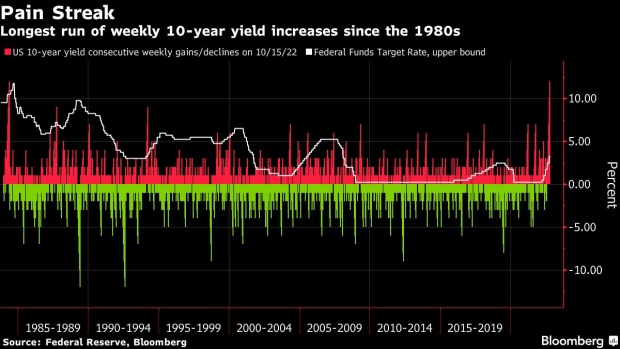Oct 20, 2022
Treasuries Tumble Into Longest Slump Since 1984 on Hawkish Fed
, Bloomberg News

(Bloomberg) -- US Treasuries tumbled Friday, driving most benchmark yields to the highest levels since 2007, as policy makers signaled their determination to keep raising rates until inflation is under control.
The yield on US five-year notes surpassed 4.5% for the first time since 2007, while 10-year notes jumped as high as 4.34%. That spilled over across global markets, with German bonds slumping to take 10-year yields above 2.5% for the first time since 2011.
“The global inflation bogeyman continues to scare the bond markets,” said strategists at Societe Generale SA including Ninon Bachet. “Central banks have additional big moves to make in their tightening process, so we remain short duration.”
Two- to five-year Treasury yields tumbled from session highs during the US morning after the Wall Street Journal reported that Federal Reserve officials were likely to debate at next month’s meeting whether to signal that a smaller rate increase is possible in December. The five-year retreated to a low of 4.38%.
The collective central-banking pivot from stimulus to tightening is placing strains on governments and economies around the world. Resurgent Treasury yields have also helped fuel dollar strength, driving currencies such as the yen to levels unseen against the greenback in over 30 years.
Fed officials are likely to raise interest rates to “well above” 4% this year and hold them at restrictive levels to combat inflation, Philadelphia Fed President Patrick Harker said on Thursday.
The selloff puts Treasuries on course for a 12-week streak of losses, the longest since 1984, when then-Fed Chairman Paul Volcker was carrying out a series of rapid rate hikes. It’s a similar picture for German bonds, heading for a record 12-week losing streak.
Swaps traders this week priced in the highest peak yet for the Fed’s policy rate, projecting it will top out at 5% in the first half of 2023. March and May 2023 overnight index swap contracts each exceeded 5% Thursday and continued to hover around that level Friday, before retreating to around 4.85% after the Wall Street Journal report. Both were below 4.70% as recently as Oct. 13 before US consumer inflation exceeded estimates.
“This is a kind of milestone,” former US Treasury Secretary Lawrence Summers said on Twitter Thursday about the 5% level. The market-implied terminal rate is “more likely than not to rise more.”
Tighter policy expectations also drove the yield on 10-year inflation-protected Treasuries up as much as nine basis points to 1.82%, the highest since 2009. That’s feeding through to lower equity valuations as it drags down corporate earnings.
Traders have also been ratcheting up bets on rate hikes from the European Central Bank, seeing an over 90% chance of a 75 basis-point move at its policy decision next week. Money markets expect its key rate to climb up to 3.25% by next summer, driving up euro-area yields.
German yields took another leg higher after the nation’s lower house of parliament approved a plan to borrow as much as €200 billion ($195 billion) to tackle the energy crisis as well as the required suspension this year of a constitutional limit on net debt. Traders are girding for a wave of issuance across Europe, with the market facing more to digest with the end of outright bond purchases by the ECB.
The moves rippled across the world. On Friday, the yield on three-year Australian debt surged 15 basis points to 3.78%, a 10-year high. The Bank of Japan was forced to intervene for a second day to try and hold the 10-year yield at its 0.25% ceiling, with the yen hitting a fresh 32-year low against the dollar.
The Fed has hiked its policy rate five times since March and the market is expecting a fourth consecutive three-quarter-point increase at the next meeting in November.
--With assistance from Libby Cherry, Greg Ritchie, Aline Oyamada and Elizabeth Stanton.
(Adds reaction to Wall Street Journal Fed report in fourth and eighth paragraphs.)
©2022 Bloomberg L.P.





